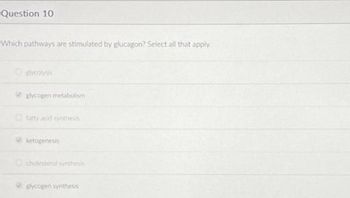
Human Anatomy & Physiology (11th Edition)
11th Edition
ISBN: 9780134580999
Author: Elaine N. Marieb, Katja N. Hoehn
Publisher: PEARSON
expand_more
expand_more
format_list_bulleted
Question

Transcribed Image Text:Question 10
Which pathways are stimulated by glucagon? Select all that apply.
glycogen metabolism
tatty acid synthesis
ketogenesis
cholesterol synthesis
glycogen synthesis
Expert Solution
This question has been solved!
Explore an expertly crafted, step-by-step solution for a thorough understanding of key concepts.
Step by stepSolved in 3 steps

Knowledge Booster
Learn more about
Need a deep-dive on the concept behind this application? Look no further. Learn more about this topic, biology and related others by exploring similar questions and additional content below.Similar questions
- Glucose-6-phosphate isomerase is used to do which of the following steps of glycolysis Select one: a. Glucose-6-phosphate is converted to Fructose-6-phosphate b. 3-phosphoglycerate is converted 2-phosphoglycerate c. Glyceraldehyde-3-phosphate is converted to 1,3 Bisphosphoglycerate d. Glucose is converted to Glucose-6-phosphate e. Dihydroxyacetone (Glycerone Phosphate) is converted to Glyceraldehyde-3-phosphate f. Fructose-1,6 Bisphosphate is converted to Dihydroxyacetone and Glyceraldehyde-3-phosphate g. 1,3 Bisphosphoglycerate is converted to 3-phosphoglycerate h. Phosphoenolpyruvate is converted to pyruvate i. Fructose-6-phosphate is converted to Fructose-1,6,bisphosphate j. 2-phosphoglycerate is converted to Phosphoenolpyruvatearrow_forwardUpon exposure to glucagon, what is the phosphorylation state and activity of Triacylglycerol Lipase? O Phosphorylated, active O Unphosphorylated, active O Phosphorylated, inactive O Unphosphorylated, inactivearrow_forwardHow do glucagon and epinephrine affect glycogen in the liver? They increase both glycogen breakdown and gluconeogenesis. They increase both glycogen breakdown and glycolysis. They increase glycolysis to breakdown glucose. They increase glycogenin synthesis.arrow_forward
- What process does a liver cell perform when there is excess glucose it needs to store? Group of answer choices Glycogenesis Glycolysis Gluconeogenesis Glycogenolysisarrow_forwardWhich of the following enzymes is/are necessary to break down glycogen into glucose monomers? Choose all that apply. Sucrose OTypsinogen Zymogen Amylasearrow_forwardGlycogenolysis and gluconeogenesis are considered futile cycles. True Falsearrow_forward
- Which pathways are utilized in order to allow for glucose from glycogen to be converted to ribose 5-phosphate while generating NADPH? Select all that apply. Glycogenolysis Glycogenesis Glycolysis Gluconeogenesis Pentose Phosphate Pathwayarrow_forwardWhich of the following metabolic pathways does NOT takes place in muscle cells? Tricarboxylic acid cycle Glycogenesis Glycogenolysis Conversion of ketone bodies to acetyl CoA Pentose phosphate pathwayarrow_forwardPlease answer this question with the simplest answer and no more than five sentencesarrow_forward
- An individual goes in to get their blood work results for their enzyme deficiency in glycolysis. Based on the results, provide an explanation of which enzymes are deficient in the individual? Blood Glucose levels are normal *Glucose-6 phosphate, *fructose-6 phosphate, *fructose-1,6 biphosphate, *glyceraldehyde-3 phosphate, *1,3-biphosphoglycerate, and *phosphoenolpyruvate levels are ALL increased Pyruvate, ATP, and RBC concentration are all at a decreased levelarrow_forwardWhy does epinephrine stimulate glycolysis? I know why epinephrine stimulates glycogenolysis which is to release glucose stores. But epinephrine stimulating glycolysis seems counterintuitive as it would synthesize less glucose and more pyruvate?arrow_forwardIn a diabetic liver, which of the following pathways would be constantly active? O glycolysis O glycogen synthesis O ketone body oxidation O gluconeogenesis O fatty acid synthesisarrow_forward
arrow_back_ios
SEE MORE QUESTIONS
arrow_forward_ios
Recommended textbooks for you
 Human Anatomy & Physiology (11th Edition)BiologyISBN:9780134580999Author:Elaine N. Marieb, Katja N. HoehnPublisher:PEARSON
Human Anatomy & Physiology (11th Edition)BiologyISBN:9780134580999Author:Elaine N. Marieb, Katja N. HoehnPublisher:PEARSON Biology 2eBiologyISBN:9781947172517Author:Matthew Douglas, Jung Choi, Mary Ann ClarkPublisher:OpenStax
Biology 2eBiologyISBN:9781947172517Author:Matthew Douglas, Jung Choi, Mary Ann ClarkPublisher:OpenStax Anatomy & PhysiologyBiologyISBN:9781259398629Author:McKinley, Michael P., O'loughlin, Valerie Dean, Bidle, Theresa StouterPublisher:Mcgraw Hill Education,
Anatomy & PhysiologyBiologyISBN:9781259398629Author:McKinley, Michael P., O'loughlin, Valerie Dean, Bidle, Theresa StouterPublisher:Mcgraw Hill Education, Molecular Biology of the Cell (Sixth Edition)BiologyISBN:9780815344322Author:Bruce Alberts, Alexander D. Johnson, Julian Lewis, David Morgan, Martin Raff, Keith Roberts, Peter WalterPublisher:W. W. Norton & Company
Molecular Biology of the Cell (Sixth Edition)BiologyISBN:9780815344322Author:Bruce Alberts, Alexander D. Johnson, Julian Lewis, David Morgan, Martin Raff, Keith Roberts, Peter WalterPublisher:W. W. Norton & Company Laboratory Manual For Human Anatomy & PhysiologyBiologyISBN:9781260159363Author:Martin, Terry R., Prentice-craver, CynthiaPublisher:McGraw-Hill Publishing Co.
Laboratory Manual For Human Anatomy & PhysiologyBiologyISBN:9781260159363Author:Martin, Terry R., Prentice-craver, CynthiaPublisher:McGraw-Hill Publishing Co. Inquiry Into Life (16th Edition)BiologyISBN:9781260231700Author:Sylvia S. Mader, Michael WindelspechtPublisher:McGraw Hill Education
Inquiry Into Life (16th Edition)BiologyISBN:9781260231700Author:Sylvia S. Mader, Michael WindelspechtPublisher:McGraw Hill Education

Human Anatomy & Physiology (11th Edition)
Biology
ISBN:9780134580999
Author:Elaine N. Marieb, Katja N. Hoehn
Publisher:PEARSON

Biology 2e
Biology
ISBN:9781947172517
Author:Matthew Douglas, Jung Choi, Mary Ann Clark
Publisher:OpenStax

Anatomy & Physiology
Biology
ISBN:9781259398629
Author:McKinley, Michael P., O'loughlin, Valerie Dean, Bidle, Theresa Stouter
Publisher:Mcgraw Hill Education,

Molecular Biology of the Cell (Sixth Edition)
Biology
ISBN:9780815344322
Author:Bruce Alberts, Alexander D. Johnson, Julian Lewis, David Morgan, Martin Raff, Keith Roberts, Peter Walter
Publisher:W. W. Norton & Company

Laboratory Manual For Human Anatomy & Physiology
Biology
ISBN:9781260159363
Author:Martin, Terry R., Prentice-craver, Cynthia
Publisher:McGraw-Hill Publishing Co.

Inquiry Into Life (16th Edition)
Biology
ISBN:9781260231700
Author:Sylvia S. Mader, Michael Windelspecht
Publisher:McGraw Hill Education